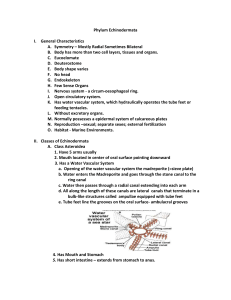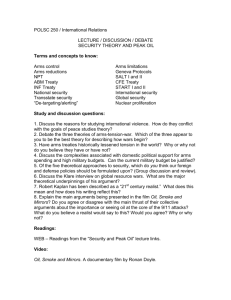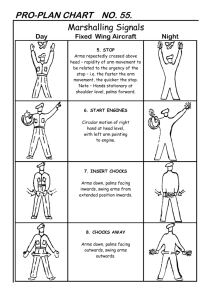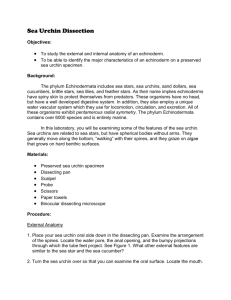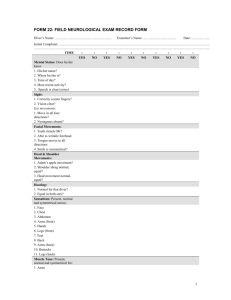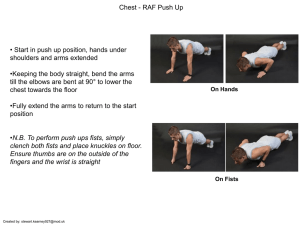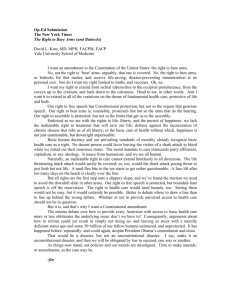echinoderm terminology
advertisement
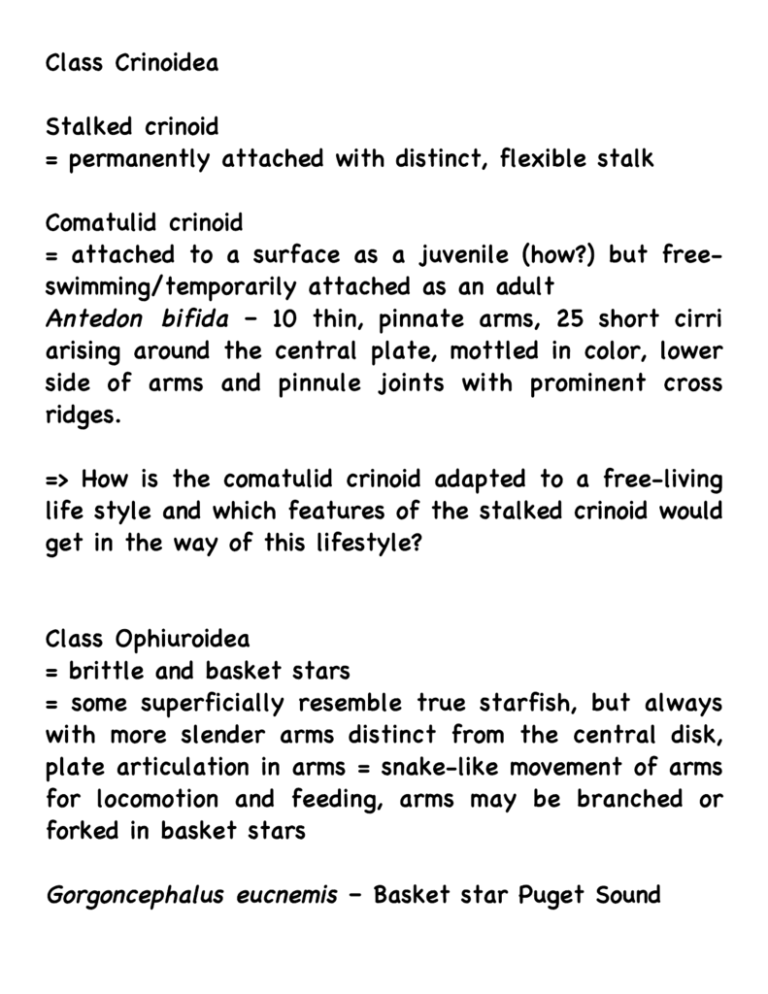
Class Crinoidea Stalked crinoid = permanently attached with distinct, flexible stalk Comatulid crinoid = attached to a surface as a juvenile (how?) but freeswimming/temporarily attached as an adult Antedon bifida – 10 thin, pinnate arms, 25 short cirri arising around the central plate, mottled in color, lower side of arms and pinnule joints with prominent cross ridges. => How is the comatulid crinoid adapted to a free-living life style and which features of the stalked crinoid would get in the way of this lifestyle? Class Ophiuroidea = brittle and basket stars = some superficially resemble true starfish, but always with more slender arms distinct from the central disk, plate articulation in arms = snake-like movement of arms for locomotion and feeding, arms may be branched or forked in basket stars Gorgoncephalus eucnemis – Basket star Puget Sound = arms branch dichotomous, central disk generally darker than the rays, color may vary from orange-red to pink and even almost white with a variety of different color morphs, why are these not individual species? What is the advantage of different color morphs? Ophioderma brevispina – common brittle star = in seagrasses between Cape Cod and Brazil, dark brittle star with 7-8 spines projecting from each arm segment, central disk = 10-15mm, arm length 40-60mm Live Ophiuroids to observe snakelike movement of the arms take a drop of carmine: seawater suspension and place on the oral disk to test for ciliary movement Class Asteroidea Asterias rubens – Common sea star External anatomy: five arms, ill defined central disk, oral and aboral surface, mouth, ambulacral groove with tubefeet (make a slide of tubefeet to visualize their structure), madreporite (view under dissecting microscope to observe fine structure, what is this structure possibly used for?), spines, pedicellariae (try to remove and place on a slide to view structure, what are these structures used for?), eyespots Internal anatomy: coelom, pyloric stomach, cardiac stomach (difference), gonads (how many? can you determine the gender?), (intestine and anus), ring canal, radial canal, ampullae, Tiedemann’s bodies (dissecting microscope) Asterias rubens – models View external and internal structures as marked Asterias rubens – arm cs Ossicles, body wall musculature, coelomic epithelium, ampullae (with musculature, observe directionality of musculature), tubefoot (observe musculature directionality), pedicellaria, dermal branchiae, gonads Asterias rubens – development, bipinnaria and brachiolaria larvae (compare to pluteus which you will be producing yourself) Oreaster reticulatus – Carribean cushion star Large, non-delineated central disk, obvious dermal spines Pisaster ochraceus – Pacific sea star Brownish color, arm number may vary between 4-7, movement through tubefeet not snake-like arm movements as ophiuroids Patirina miniata – Bat star Webbed rays, commonly found with 5 rays (sometimes 49), of up to 10 cm in length, color from red to yellow Class Echinoidea Arbacia punctulata – purple urchin External anatomy: test, ambulacra and interambulacra (how do they differ and how many are there?), genital plates, periprocts, madreporite, tubefeet (make a slide preparation to see structure; buccal, ambulacral) pedicellariae (make slide preparations), spines (view the spine attachment), peristomial membrane, mouth (teeth Aristotle’s lantern), gills Internal anatomy: esophagus, stomach, intestine, gonads, ampullae, ring canal with polian vesicles Aristotle’s lantern: pyramid, rotule, epiphysis, compass elevator muscle, lantern retractor muscle, lantern protractor Lytechinus variegatus – variegated sea urchins Live animals were available the previous week for embryology, you should have observed pluteus larva Strongylocentrotus droebachiensis – green sea urchin Test only, observe spine attachment and distinguish between ambulacra and interambulacra Encope emarginata – sand dollar Observe petaloid ambulacra, genital pores, mouth, food grooves Melitta quinquiesperforata – key hole urchin Petaloid ambulacra used as gills, 5 oval shaped holes (= lunules), contain Aristotle’s lantern with teeth shaped like “doves” Spatangoid sea urchin = heart urchin Petaloid ambulacra (= phyllode), mouth, periproct, anus Class Holothuroidea Cucumaria sp. – common sea cucumber External anatomy: oral-aboral axis, branched tentacles (buccal podia, how many?), introvert, podia, anus, microscopic ossicles in the body wall are all that remains of the typical echinoderm test (how does that suit the animal’s lifestyle?) Internal anatomy: ring canal, esophagus, stomach, intestine, cloaca, respiratory tree, gonad, longitudinal muscle bands, ampullae

